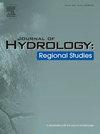Contribution of snow water equivalent to the terrestrial water storage changes in High Mountain Asia based on multiple datasets
IF 4.7
2区 地球科学
Q1 WATER RESOURCES
引用次数: 0
Abstract
Study region
High Mountain Asia.
Study focus
Snow water equivalent (SWE) storage is a crucial component of the terrestrial water storage (TWS) in High Mountain Asia (HMA). This study employed monthly data from the Global Land Data Assimilation System (GLDAS) NOAH, GLDAS catchment land surface model (CLSM), European Centre for Medium Range Weather Forecasts reanalysis version 5 land (ERA5L), High Asia refined analysis (HAR), and the China Meteorological Administration’s global Land surface reanalysis Interim (CRA) during 2003–2020 to compare the TWS anomaly (TWSA). Additionally, the contribution of SWE to the TWS changes was estimated.
New hydrological insights for the region
The results reveal that the TWSA had a large variability for the multiple datasets while the SWE anomaly (SWEA) time series exhibited more consistent fluctuations. The annual percentage of the SWEA to the TWSA ranged between 7.40–26.95 % for the multiple datasets, indicating the relatively important role of the SWE dynamics in the study area. Three main types of contributions were found in HMA, i.e., positive contributions when the TWSA and SWEA both decreased or both increased, and a negative contribution when the SWEA increased and the TWSA decreased. The individual role of the SWEA in controlling the total TWSA showed large regional and seasonal heterogeneity. The results of this study provide an essential reference for water management and availability to large downstream population.
求助全文
约1分钟内获得全文
求助全文
来源期刊

Journal of Hydrology-Regional Studies
Earth and Planetary Sciences-Earth and Planetary Sciences (miscellaneous)
CiteScore
6.70
自引率
8.50%
发文量
284
审稿时长
60 days
期刊介绍:
Journal of Hydrology: Regional Studies publishes original research papers enhancing the science of hydrology and aiming at region-specific problems, past and future conditions, analysis, review and solutions. The journal particularly welcomes research papers that deliver new insights into region-specific hydrological processes and responses to changing conditions, as well as contributions that incorporate interdisciplinarity and translational science.
 求助内容:
求助内容: 应助结果提醒方式:
应助结果提醒方式:


